Si and Ca individually and combinatorially target enhanced MC3T3-E1 subclone 4 early osteogenic marker expression
- PMID: 22913306
- PMCID: PMC6597170
- DOI: 10.1563/AAID-JOI-D-11-00108
Si and Ca individually and combinatorially target enhanced MC3T3-E1 subclone 4 early osteogenic marker expression
Abstract
This study tests the hypothesis that silicon and calcium ions combinatorially target gene expression during osteoblast differentiation. MC3T3-E1 subclone 4 osteoblast progenitors (transformed mouse calvarial osteoblasts) were exposed to Si(4+) (from Na(2)SiO(3)) and Ca(2+) (from CaCl(2):H(2)O) ion treatments both individually (0.4 mM each + control treatment) and combinatorially (0.4 mM Si(4+) + 0.4 mM Ca(2+) + control treatment) and compared to control treated (α-minimum essential medium, 10% fetal bovine serum, and 1% penicillin-streptomycin) cells. Cell proliferation studies showed no significant increase in cell density between treatments over 5 days of culture. Cellular differentiation studies involved addition of ascorbic acid (50 mg/L) for all treatments. Relative gene expression was determined for collagen type 1 (Col(I)α1/Col(I)α2), core-binding factor a (cbfa1/Runx2), and osteocalcin (OCN), which indicated osteoblast progenitor differentiation into a mineralizing phenotype. Increased Si(4+) or Ca(2+) ion treatments enhanced Col(I)α1, Col(I)α2, Runx2, and OCN expression, while increased Si(4+) + Ca(2+) ion treatments enhanced OCN expression. Moreover, it was found that a Si(4+)/Ca(2+) ratio of unity was optimal for maximal expression of OCN. Collagen fiber bundles were dense, elongated, and thick within extracellular matrices (ECM) exposed to Si(4+) and Si(4+) + Ca(2+) treatments, while collagen fiber bundles were sparse, short, and thin within Ca(2+) and control treated ECM. These results indicated that individual ions enhance multiple osteogenic gene expression, while combined ion treatments enhance individual gene expression. In addition, these results indicated that Si(4+) enhanced osteoblast gene expression and ECM formation at higher levels than Ca(2+). These results support the larger concept that ions (possibly released from bioactive glasses) could control bone formation by targeting osteoblast marker expression.
Figures

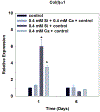
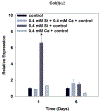
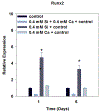
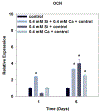
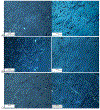


Similar articles
-
Enhanced osteocalcin expression by osteoblast-like cells (MC3T3-E1) exposed to bioactive coating glass (SiO2-CaO-P2O5-MgO-K2O-Na2O system) ions.Acta Biomater. 2009 Nov;5(9):3536-47. doi: 10.1016/j.actbio.2009.05.035. Epub 2009 Jun 2. Acta Biomater. 2009. PMID: 19497391 Free PMC article.
-
Combinatorial effect of Si4+, Ca2+, and Mg2+ released from bioactive glasses on osteoblast osteocalcin expression and biomineralization.Mater Sci Eng C Mater Biol Appl. 2013 Jul 1;33(5):2757-65. doi: 10.1016/j.msec.2013.02.044. Epub 2013 Mar 1. Mater Sci Eng C Mater Biol Appl. 2013. PMID: 23623093
-
Enhanced osteoprogenitor elongated collagen fiber matrix formation by bioactive glass ionic silicon dependent on Sp7 (osterix) transcription.J Biomed Mater Res A. 2016 Oct;104(10):2604-15. doi: 10.1002/jbm.a.35795. Epub 2016 Aug 15. J Biomed Mater Res A. 2016. PMID: 27279631 Free PMC article.
-
Platelet-derived growth factor receptor kinase inhibitor AG-1295 promotes osteoblast differentiation in MC3T3-E1 cells via the Erk pathway.Biosci Trends. 2012 Jun;6(3):130-5. doi: 10.5582/bst.2012.v6.3.130. Biosci Trends. 2012. PMID: 22890161
-
The effect of Si species released from bioactive glasses on cell behaviour: A quantitative review.Acta Biomater. 2023 Oct 15;170:39-52. doi: 10.1016/j.actbio.2023.09.012. Epub 2023 Sep 14. Acta Biomater. 2023. PMID: 37714247 Review.
Cited by
-
In vitro biocompatibility and bioactivity of calcium silicate‑based bioceramics in endodontics (Review).Int J Mol Med. 2021 Jul;48(1):128. doi: 10.3892/ijmm.2021.4961. Epub 2021 May 20. Int J Mol Med. 2021. PMID: 34013376 Free PMC article. Review.
-
Lithium-silicate sol-gel bioactive glass and the effect of lithium precursor on structure-property relationships.J Solgel Sci Technol. 2017;81(1):84-94. doi: 10.1007/s10971-016-4097-x. Epub 2016 Jun 23. J Solgel Sci Technol. 2017. PMID: 32009741 Free PMC article.
-
Water-soluble factors eluated from surface pre-reacted glass-ionomer filler promote osteoblastic differentiation of human mesenchymal stem cells.Mol Med Rep. 2018 Mar;17(3):3448-3454. doi: 10.3892/mmr.2017.8287. Epub 2017 Dec 18. Mol Med Rep. 2018. PMID: 29257332 Free PMC article.
-
Decreasing NF-κB expression enhances odontoblastic differentiation and collagen expression in dental pulp stem cells exposed to inflammatory cytokines.PLoS One. 2015 Jan 28;10(1):e0113334. doi: 10.1371/journal.pone.0113334. eCollection 2015. PLoS One. 2015. PMID: 25629155 Free PMC article.
-
Effect of the ionic product of bioglass 60s on osteoblastic activity in canines.BMC Vet Res. 2015 Sep 30;11:247. doi: 10.1186/s12917-015-0558-7. BMC Vet Res. 2015. PMID: 26423445 Free PMC article.
References
Publication types
MeSH terms
Substances
Grants and funding
LinkOut - more resources
Full Text Sources
Other Literature Sources
Medical
Miscellaneous

